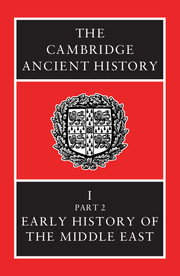Book contents
- Frontmatter
- Contents
- List of Maps
- List of Tables
- List of Text-figures
- Preface
- CHAPTER XI THE EARLY DYNASTIC PERIOD IN EGYPT
- CHAPTER XII THE LAST PREDYNASTIC PERIOD IN BABYLONIA
- CHAPTER XIII THE CITIES OF BABYLONIA
- CHAPTER XIV THE OLD KINGDOM IN EGYPT AND THE BEGINNING OF THE FIRST INTERMEDIATE PERIOD
- CHAPTER XV PALESTINE IN THE EARLY BRONZE AGE
- CHAPTER XVI THE EARLY DYNASTIC PERIOD IN MESOPOTAMIA
- CHAPTER XVII SYRIA BEFORE 2200 B.C.
- CHAPTER XVIII ANATOLIA, c. 4000–2300 b.c.
- CHAPTER XIX THE DYNASTY OF AGADE AND THE GUTIAN INVASION
- CHAPTER XX THE MIDDLE KINGDOM IN EGYPT: INTERNAL HISTORY FROM THE RISE OF THE HERACLEOPOLITANS TO THE DEATH OF AMMENEMES III
- CHAPTER XXI SYRIA AND PALESTINE c. 2160–1780 b.c.
- CHAPTER XXII BABYLONIA, c. 2120–1800 B.C.
- CHAPTER XXIII PERSIA, c. 2400–1800 B.C.
- CHAPTER XXIV (a) ANATOLIA, c. 2300–1750 B.C.
- CHAPTER XXIV(b) ANATOLIA IN THE OLD ASSYRIAN PERIOD
- CHAPTER XXV ASSYRIA, c. 2600–1816 B.C.
- CHAPTER XXVI(a) GREECE, CRETE, AND THE AEGEAN ISLANDS IN THE EARLY BRONZE AGE
- CHAPTER XXVI(b) CYPRUS IN THE EARLY BRONZE AGE
- CHAPTER XXVII IMMIGRANTS FROM THE NORTH
- BIBLIOGRAPHIES
- Chronological Tables
- Index to Maps
- General Index
- Map 6. Babylonia and Western Persia.
- Map 12. Early Bronze Age sites in Greece and the Aegean Islands.
- Map 16. Map to illustrate movements of northern peoples in the third to first millennia B.C.
- References
CHAPTER XVI - THE EARLY DYNASTIC PERIOD IN MESOPOTAMIA
Published online by Cambridge University Press: 28 March 2008
- Frontmatter
- Contents
- List of Maps
- List of Tables
- List of Text-figures
- Preface
- CHAPTER XI THE EARLY DYNASTIC PERIOD IN EGYPT
- CHAPTER XII THE LAST PREDYNASTIC PERIOD IN BABYLONIA
- CHAPTER XIII THE CITIES OF BABYLONIA
- CHAPTER XIV THE OLD KINGDOM IN EGYPT AND THE BEGINNING OF THE FIRST INTERMEDIATE PERIOD
- CHAPTER XV PALESTINE IN THE EARLY BRONZE AGE
- CHAPTER XVI THE EARLY DYNASTIC PERIOD IN MESOPOTAMIA
- CHAPTER XVII SYRIA BEFORE 2200 B.C.
- CHAPTER XVIII ANATOLIA, c. 4000–2300 b.c.
- CHAPTER XIX THE DYNASTY OF AGADE AND THE GUTIAN INVASION
- CHAPTER XX THE MIDDLE KINGDOM IN EGYPT: INTERNAL HISTORY FROM THE RISE OF THE HERACLEOPOLITANS TO THE DEATH OF AMMENEMES III
- CHAPTER XXI SYRIA AND PALESTINE c. 2160–1780 b.c.
- CHAPTER XXII BABYLONIA, c. 2120–1800 B.C.
- CHAPTER XXIII PERSIA, c. 2400–1800 B.C.
- CHAPTER XXIV (a) ANATOLIA, c. 2300–1750 B.C.
- CHAPTER XXIV(b) ANATOLIA IN THE OLD ASSYRIAN PERIOD
- CHAPTER XXV ASSYRIA, c. 2600–1816 B.C.
- CHAPTER XXVI(a) GREECE, CRETE, AND THE AEGEAN ISLANDS IN THE EARLY BRONZE AGE
- CHAPTER XXVI(b) CYPRUS IN THE EARLY BRONZE AGE
- CHAPTER XXVII IMMIGRANTS FROM THE NORTH
- BIBLIOGRAPHIES
- Chronological Tables
- Index to Maps
- General Index
- Map 6. Babylonia and Western Persia.
- Map 12. Early Bronze Age sites in Greece and the Aegean Islands.
- Map 16. Map to illustrate movements of northern peoples in the third to first millennia B.C.
- References
Summary
BABYLONIA: ARCHAEOLOGICAL DEVELOPMENT
An earlier chapter (XIII) has described the historical development of the cities in Babylonia and their cultural background. Here we must concentrate on the archaeological evidence, for this is by far the richest source for the study of man's development in the Early Dynastic period. Indeed, when we come to discuss developments in Assyria and Mesopotamia proper, historical records are so scarce that the archaeological evidence becomes our primary source of reference.
The Early Dynastic period of Babylonia has been divided into three parts and the archaeological development has been traced through an exhaustive analysis of stratified objects. At present the most satisfactory ground for this study is the Diyālā valley, where extensive excavations have provided a detailed and continuous relationship between buildings and the small finds associated with them. The principal objects were cylinder seals, pottery, sculpture and metal. Each category was subjected to stylistic examination and compared with similar material from sites outside the Diyālā valley. In the Diyālā district itself no mound proved more rewarding than Khafājī, where the long sequence of ‘Sin Temples’ could be related to many other less complete sequences of religious and domestic buildings discovered there and elsewhere.
The analysis of style is, however, complicated by the fact that development did not proceed pari passu everywhere. Thus solid-footed clay goblets which were used in the Uruk-Jamdat Nasr period at Warka, Ur and Nippur did not appear before Early Dynastic I on the Diyālā the same observation applies to reserved slip ware. Archaic seals frequently occur in contexts much later than those to which they originally belonged.
- Type
- Chapter
- Information
- The Cambridge Ancient History , pp. 238 - 314Publisher: Cambridge University PressPrint publication year: 1971
References
- 2
- Cited by

